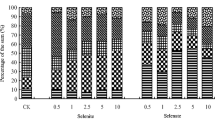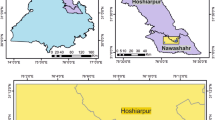Abstract
Purpose
Selenium (Se) adsorption influences its mobility, transformation, and bioavailability in soil. Se interactions with soils and soil constituents have focused primarily on selenite retention. The dominant factors of selenite adsorption behavior and the impacts of exogenous Se concentration were investigated for the prediction of the rate of retention and release of selenium species in soils and the guidance of Se supplementation implementation.
Materials and methods
Eighteen typical agricultural soils with varying physicochemical characteristics and mineralogical composition were collected throughout China for the study of their adsorption and desorption behavior toward selenite and the effect of their physicochemical properties.
Results and discussion
Results showed that Se adsorbances among 18 soils varied considerably. Among numerous soil properties and components, soil pH exerted a significant negative effect on selenite adsorption in soil, whereas amorphous iron and amorphous aluminum had positive effect (P < 0.05). Organic matter (OM) showed an indirect effect when high concentrations of selenite were present in soil. Moreover, soil carbonate content imposed an indirect effect on selenite adsorption in soil. Selenite desorption showed a reverse trend compared with adsorption: the correlations of desorption rate with soil pH and amorphous iron were positive and negative, respectively (P < 0.05). The soil/solution distribution coefficient (K d) had no significant correlation with soil properties, other than with pH (P < 0.05), but the K d values of different soils were highly variable.
Conclusions
The observed adsorption behavior of selenite in soil is complicated: small amounts of exogenous Se were mainly adsorbed by a monolayer physical process, but multilayer adsorption occurred when the concentration increased. The soils that strongly adsorb selenite often showed low desorption rates, as well, which largely limited the migration, transformation, and bioavailability of selenite in soils. Therefore, residue problem must be considered when Se fertilizers are applied to these soils.



Similar content being viewed by others
References
Bao SD (2000) Soil and agricultural chemistry analysis. Beijing, pp 30–35
Blaylock MJ, Tawfic TA, Vance GF (1995) Modeling selenite adsorption in reclaimed coal mine soil materials. Soil Sci 159:43–48
Chan YT, Kuan WH, Chen TY et al (2009) Adsorption mechanism of selenate and selenite on the binary oxide systems. Water Res 43:4412–4420
Donald GM, Randal JS, Robert JZ (2014) Rhizosphere effects on soil solution composition and mineral stability. Geoderma 226–227:340–347
Gabos MB, Goldberg S, Alleoni LRF (2014) Modeling selenium (IV and VI) adsorption envelopes in selected tropical soils using the constant capacitance model. Environ Toxicol Chem 9999:1–11
Gerald F, Combs J (2001) Selenium in global food systems. Brit J Nutr 85:517–547
Girling CA (1984) Selenium in agriculture and the environment. Agric Ecosyst Environ 11(1):37–65
Goh KH, Lim TT (2004) Geochemistry of inorganic arsenic and selenium in a tropical soil: effect of reaction time, pH and competitive anions on arsenic and selenium adsorption. Chemosphere 55:849–859
Helinä H (2005) Biogeochemistry of selenium and its impact on food chain quality and human health. J Trace Elem Med Biol 18(4):309–318
Tolu J, Thiry Y, Bueno M et al (2014) Distribution and speciation of ambient selenium in contrasted soils, from mineral to organic rich. Sci Total Environ 479:93–101
Kamei-Ishikawa N, Tagami K, Uchida S (2007) Sorption kinetics of selenium on humic acid. J Radioanal Nucl Chem 274:551–561
Keskinen R, Raty M, Yli-Halla M (2011) Selenium fractions in selenate-fertilized field soils of Finland. Nutr Cycl Agroecosyst 91:17–29
Lee SH, Doolittle JJ, Woodard HJ (2011) Selenite adsorption and desorption in selected south Dakota soils as a function of pH and other oxyanions. Soil Sci 176:73–79
Levander QA (1997) Selenium requirements as discussed in the 1996 joint FAO/IAEA/WHO expert consultation on trace elements in human nutrition. Biomed Environ Sci 10(2–3):214–219
Lyons G (2010) Selenium in cereals: improving the efficiency of agronomic biofortification in the UK. Plant Soil 332:1–4
Nakamaru Y, Tagami K, Uchida S (2005a) Distribution coefficient of selenium in Japanese agricultural soils. Chemosphere 58:1347–1354
Mandal S, Mayadevi S, Kulkarni BD (2009) Adsorption of aqueous selenite [Se(IV)] species on synthetic layered double hydroxide materials. Ind Eng Chem Res 48(17):7893–7898
Muller J, Abdelouas A, Ribet S et al (2012) Sorption of selenite in a multi-component system using the “dialysis membrane” method. Appl Geochem 27(12):2524–2532
Nakamaru Y, Tagami K, Uchida S (2005b) Distribution coefficient of selenium in Japanese agricultural soils. Chemosphere 58(10):1347–1354
Neal RH, Sposito G, Holtzclaw KM et al (1987a) Selenite adsorption on alluvial soils: I. Soil composition and pH effects. Soil Sci Soc Am J 51:1161–1165
Neal RH, Sposito G, Holtzclaw KM et al (1987b) Selenite adsorption on alluvial soils: II. Solution composition effects. Soil Sci Soc Am J 51:1165–1169
Neal RH, Sposito G (1989) Selenate adsorption on alluvial soils. Soil Sci Soc Am J 53:70–74
Peak D (2006) Adsorption mechanisms of selenium oxyanions at the aluminum oxide/water interface. J Colloid Interface Sci 303:337–345
Rayman MP (2008) Food-chain selenium and human health: emphasis on intake. Nutr Res 100:254–268
Seppanen MM, Kontturi J, Heras IL et al (2010) Agronomic biofortification of Brassica with selenium-enrichment of SeMet and its identification in Brassica seeds and meal. Plant Soil 337:273–283
Song JY, Zhang WY, Wang YH, Yin J (2005) Studies on technique in producing wheat of enriched selenium. Bull China Agron 21:197–199
Su C, Suarez DL (2000) Selenate and selenite sorption on iron oxides: an infrared and e1ectrophoretic study. Soil Sci Soc Am J 64:101–111
Szlachta M, Gerda V, Chubar N (2012) Adsorption of arsenite and selenite using an inorganic ion exchanger based on Fe-Mn hydrous oxide. J Colloid Interf Sci 365(1):213–221
Su T, Guan X, Gu G, Wang J (2008) Adsorption characteristics of As(V), Se(IV), and V(V) onto activated alumina: effects of pH, surface loading, and ionic strength. J Colloid Interface Sci 326(2):347–353
Tan JA, Zhu W, Wang W, Li R, Hou S, Wang D, Yang L (2002) Selenium in soil and endemic diseases in China. Sci Total Environ 284(1):227–235
Wang SS, Wu XP, Liang DL et al (2010) Transformation and bioavailability for Pak choi (Brassica chinensis) of different forms of selenium added to calcareous soil. Acta Sci Circumst 30(12):2499–2505
Wada K, Abd-Elfattah A (1978) Characterization of zinc adsorption sites in two mineral soils. Soil Sci Plant Nutr 24:417–426
Whanger PD (2004) Selenium and its relationship to cancer: an update. Brit J Nutr 91:11–28
Yang XE, Chen WR, Feng Y (2007) Improving human micronutrient nutrition through biofortification in the soil–plant system: China as a case study. Environ Geochem Health 29(5):413–428
Acknowledgments
The present study was supported by the National Natural Science Foundation of China (No. 41171379) and the Innovative Research Team Program of Northwest A&F University.
Author information
Authors and Affiliations
Corresponding author
Additional information
Responsible editor: Ravi Naidu
Rights and permissions
About this article
Cite this article
Li, Z., Man, N., Wang, S. et al. Selenite adsorption and desorption in main Chinese soils with their characteristics and physicochemical properties. J Soils Sediments 15, 1150–1158 (2015). https://doi.org/10.1007/s11368-015-1085-7
Received:
Accepted:
Published:
Issue Date:
DOI: https://doi.org/10.1007/s11368-015-1085-7




